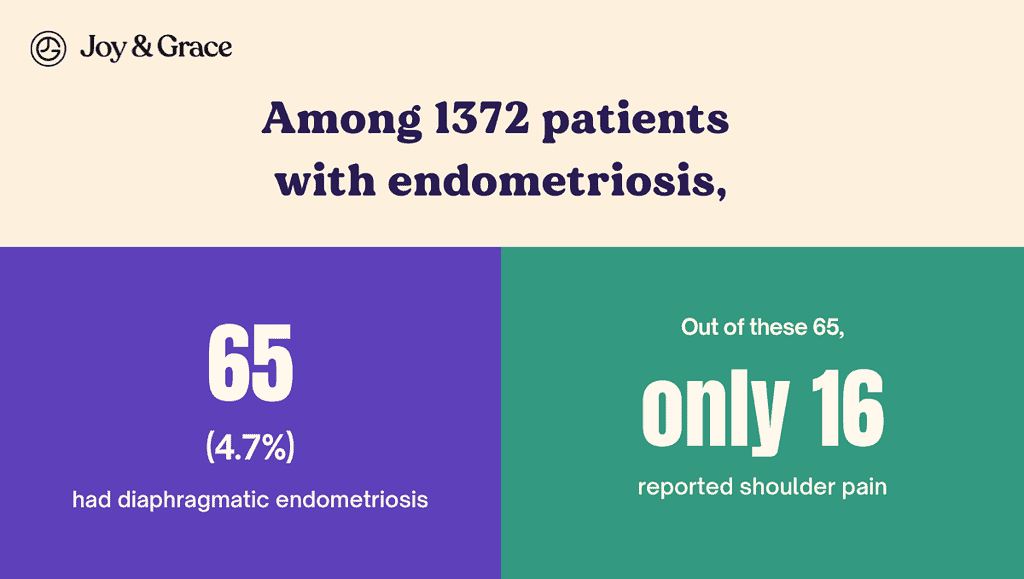If you're experiencing shoulder pain and have been diagnosed with endometriosis, you may wonder if the two are related.
Endometriosis affects about 10% (190 million) of all women and girls of reproductive age worldwide. And shoulder pain is one of the lesser-known symptoms.
In this article, we'll explore the connection between endometriosis and shoulder pain. We'll also discuss why it happens and what treatment options are available.
Keep reading to learn more.
Can Endometriosis Cause Shoulder Pain?
A type of endometriosis called diaphragmatic endometriosis can cause shoulder pain.
That said, endometriosis without diaphragm involvement does not cause shoulder pain.
Additionally, diaphragmatic endometriosis is rare. And even when it happens, most people with it still don’t have shoulder pain.
To give an idea of how rare it is, we can look at a 2023 study conducted in Switzerland.
In the study, researchers tried to find out how many people with endometriosis also had diaphragm involvement.
Additionally, researchers also documented how many of them had shoulder pain.

Here’s how the results showed up. Among 1372 patients with endometriosis:
- 65 (4.7%) had diaphragmatic endometriosis, and
- Out of these 65, only 16 reported shoulder pain.
Hence, shoulder pain was reported in roughly 27% of all diaphragmatic endometriosis cases in the study.
“Why some patients with DE develop local symptoms, and others do not, has not been determined to date,” the authors say.
So, although (diaphragmatic) endometriosis can cause shoulder pain, in most cases, it does not.
What Is Diaphragmatic Endometriosis?
Endometriosis is a disease in which tissue similar to the interior lining of the uterus, is also found in other organs.
This tissue can also grow all the way up to the diaphragm in rare cases. When this happens, it is called diaphragmatic endometriosis.
When translated literally, endometriosis means “disease of the interior lining of the uterus.” But as you can see, that doesn’t tell the whole story.
Endometriosis usually affects the ovaries, the fallopian tubes, and the tissue that lines the pelvis. That means uterus tissue is also found in the ovaries, the fallopian tubes, etc. Diaphragm involvement, as we saw earlier, is infrequent.
One might see a resemblance between endometriosis and a more severe condition, like cancer.
After all, cancerous tissue also can travel to other parts of the body (metastasize).
However, endometriosis is a non-cancerous disease. It doesn't grow out of control as cancer does and can't hurt cells like cancer can.
What Causes Diaphragmatic Endometriosis?
What causes (diaphragmatic) endometriosis remains a mystery to scientists and medical professionals.
However, there are some theories:
- Menstrual blood flowing the wrong way.
During your period, menstrual blood usually flows out and leaves the body.
But sometimes, blood and endometrial cells move backward into the fallopian tubes and pelvic cavity. That is called a "retrograde period."
The endometrial cells then stick to the walls of your pelvis and pelvic organs, and they can even reach your diaphragm. These cells swell up, get thicker, and bleed during your menstrual cycle, causing endometriosis symptoms.
- Cells being wrongly transported to another part of the body.
Endometrial cells from the uterus may be transported to different parts of the body by your blood vessels or lymphatic system. In normal conditions, this shouldn’t happen.
- Cell changes due to hormones.
Estrogen and other hormones could transform normal cells into endometrial-like cells. - Problems with the immune system.
Immune system weakness makes it more likely that endometrial-like tissue may go undetected and, thus, fail to be eliminated.
What Does Diaphragm Endometriosis Feel Like?
In most people, diaphragmatic endometriosis doesn’t cause any symptoms. Most endometriotic tissues found on the diaphragm are superficial and don't hurt.
If symptoms are present, however, they vary greatly, from mild to severe.
Mild endometriosis of the diaphragm symptoms include:
- Pain in the chest that worsens when you breathe,
- Pain in the right side of the upper abdomen,
- Shoulder pain,
- Neck pain,
- Nausea, and
- Vomiting.
Endometriosis usually causes these symptoms by irritating the phrenic nerve. The phrenic nerve runs from the brain all the way down to the diaphragm.
Some people report these symptoms to come on quickly and cause sharp, severe pain in the upper abdomen, chest, and shoulder.
Others report only vague symptoms and aches that are hard to pinpoint.
If the lesions are severe, diaphragmatic endometriosis can cause:
- Blood build-up between the chest wall and lungs,
- A collapsed lung, or
- Coughing up blood.
These symptoms occur because the endometrial tissue found in the diaphragm is the same as that in the uterus. Thus, this tissue thickens and bleeds during menstruation, just like normal uterine tissues do. When that happens, symptoms like coughing up blood, etc., ensue.
Also, because of that, symptoms usually happen during the menstruation period.
Still, in some people, they can happen anytime. Studies have shown that up to 30% of women with pelvic endometriosis have acyclical symptoms that do not align with their periods.
In the end, the severity of the disease depends on where and how deep the endometriosis lesions are.
The good news is that, as we said earlier, most people have superficial lesions. Only a small part (about 29%) are thought to have deep-infiltrating lesions.
Can Endometriosis Cause Pain In Upper Back?
Diaphragmatic endometriosis can sometimes cause a feeling of pain in the upper back.
That’s because the neck and shoulder pain can mix up and radiate to the upper back region.
However, no concrete studies report direct upper back involvement in endometriosis. As we said, the pain can mostly come “indirectly.”
Lower back pain, on the other hand, is a common sign of endometriosis, even in people whose diaphragms are not affected.
What Treatment Options Are Available?
Diaphragmatic endometriosis can be treated in three ways: by watchful waiting, medicine, or surgery.
- Watchful waiting:
This method is primarily reserved for people without symptoms whose disease has been found by accident. In these cases, doctors recommend taking an “expectant” approach. That means there will be no further intervention unless symptoms occur.
- Medicine - Hormone treatment:
If you don't plan to have kids, doctors can tell you to take medicine to treat your endometriosis. Hormones that cause endometrial tissue to build up every month can be controlled with birth control pills or patches.
Some drugs called “GnRH antagonists” reduce the amount of estrogen in your body and stop your period, which makes the endometrial tissue smaller. Along with hormone therapy, your doctor could also give you pain medicine. - Surgery:
After taking medication, people who still have pain should have surgery to remove lesions.
The good news about diaphragmatic endometriosis is that it is much less likely to come back than other types of endometriosis after it has been treated with surgery.
Doctors usually talk to patients about other options as well if surgery is done. The surgery can hurt the diaphragm, phrenic nerve, lungs, blood vessels, or heart. As with any other procedure, care should be based on the patient's goals, age, medical condition, etc.
Why Do I Have Shoulder Pain After Endometriosis Surgery?
Shoulder pain mainly occurs after pelvic - not diaphragmatic, endometriosis surgery.
That being said, many report shoulder pain after pelvic endometriosis surgery.
Shoulder pain after the surgery usually occurs because of the gas (CO2 gas) used during the procedure. This gas is used to inflate the abdomen before surgery.
At the end of the process, doctors will take most of the gas out. But sometimes, an amount might still be left. That can pressure the diaphragm, irritating the phrenic nerve, which starts in the diaphragm and ends in the shoulder.
It is estimated that shoulder pain occurs in as many as 63% of patients after surgery.
Takeaway
To sum everything up:
- Endometriosis is a disease in which tissue normally found in the uterus, grows in other organs. Endometriosis is not a type of cancer.
- Although endometriosis is common, the type that causes shoulder pain is very rare.
- Most people with diaphragmatic endometriosis don’t have symptoms at all. If present, the symptoms vary from mild to severe.
Mild cases present with symptoms like abdomen, neck, and shoulder pain. The irritation of the phrenic nerve is the culprit behind these symptoms.
Severe disease is more “bloody.” Because the tissue is the same as in the uterus, it can bleed during menstruation. When this happens, blood might accumulate above the diaphragm, in the lungs, and show symptoms like coughing up blood. - Treatment options include watchful waiting, medicine, and surgery. Luckily, most people don’t require surgery. And even if they do, the disease usually doesn’t re-occur after the procedure.
Although a potentially severe disease, diaphragmatic endometriosis, luckily, is very rare.















